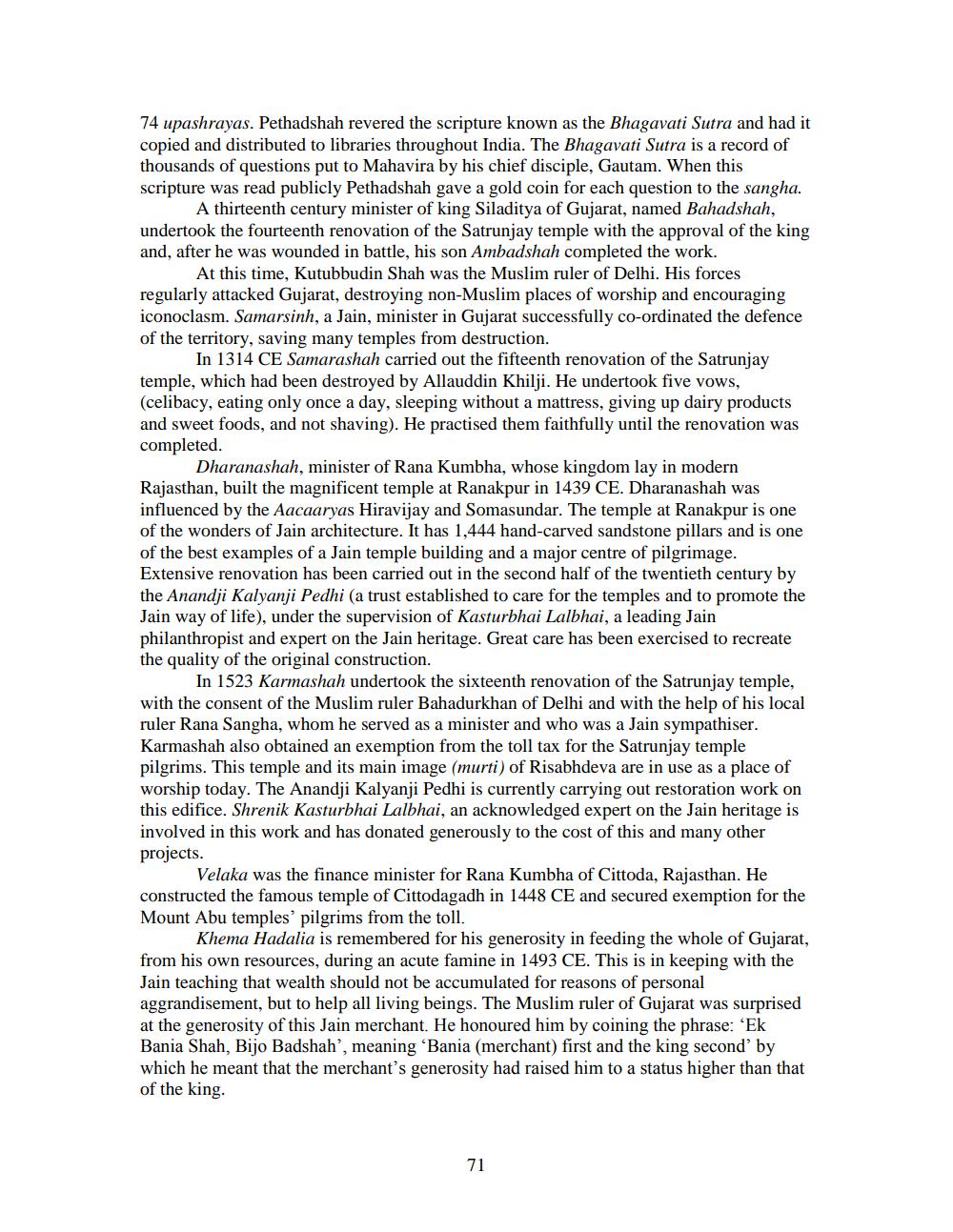________________
74 upashrayas. Pethadshah revered the scripture known as the Bhagavati Sutra and had it copied and distributed to libraries throughout India. The Bhagavati Sutra is a record of thousands of questions put to Mahavira by his chief disciple, Gautam. When this scripture was read publicly Pethadshah gave a gold coin for each question to the sangha.
A thirteenth century minister of king Siladitya of Gujarat, named Bahadshah, undertook the fourteenth renovation of the Satrunjay temple with the approval of the king and, after he was wounded in battle, his son Ambadshah completed the work.
At this time, Kutubbudin Shah was the Muslim ruler of Delhi. His forces regularly attacked Gujarat, destroying non-Muslim places of worship and encouraging iconoclasm. Samarsinh, a Jain, minister in Gujarat successfully co-ordinated the defence of the territory, saving many temples from destruction.
In 1314 CE Samarashah carried out the fifteenth renovation of the Satrunjay temple, which had been destroyed by Allauddin Khilji. He undertook five vows, (celibacy, eating only once a day, sleeping without a mattress, giving up dairy products and sweet foods, and not shaving). He practised them faithfully until the renovation was completed.
Dharanashah, minister of Rana Kumbha, whose kingdom lay in modern Rajasthan, built the magnificent temple at Ranakpur in 1439 CE. Dharanashah was influenced by the Aacaaryas Hiravijay and Somasundar. The temple at Ranakpur is one of the wonders of Jain architecture. It has 1,444 hand-carved sandstone pillars and is one of the best examples of a Jain temple building and a major centre of pilgrimage. Extensive renovation has been carried out in the second half of the twentieth century by the Anandji Kalyanji Pedhi (a trust established to care for the temples and to promote the Jain way of life), under the supervision of Kasturbhai Lalbhai, a leading Jain philanthropist and expert on the Jain heritage. Great care has been exercised to recreate the quality of the original construction.
In 1523 Karmashah undertook the sixteenth renovation of the Satrunjay temple, with the consent of the Muslim ruler Bahadurkhan of Delhi and with the help of his local ruler Rana Sangha, whom he served as a minister and who was a Jain sympathiser. Karmashah also obtained an exemption from the toll tax for the Satrunjay temple pilgrims. This temple and its main image (murti) of Risabhdeva are in use as a place of worship today. The Anandji Kalyanji Pedhi is currently carrying out restoration work on this edifice. Shrenik Kasturbhai Lalbhai, an acknowledged expert on the Jain heritage is involved in this work and has donated generously to the cost of this and many other projects.
Velaka was the finance minister for Rana Kumbha of Cittoda, Rajasthan. He constructed the famous temple of Cittodagadh in 1448 CE and secured exemption for the Mount Abu temples' pilgrims from the toll.
Khema Hadalia is remembered for his generosity in feeding the whole of Gujarat, from his own resources, during an acute famine in 1493 CE. This is in keeping with the Jain teaching that wealth should not be accumulated for reasons of personal aggrandisement, but to help all living beings. The Muslim ruler of Gujarat was surprised at the generosity of this Jain merchant. He honoured him by coining the phrase: 'Ek Bania Shah, Bijo Badshah', meaning 'Bania (merchant) first and the king second' by which he meant that the merchant's generosity had raised him to a status higher than that of the king.
71




